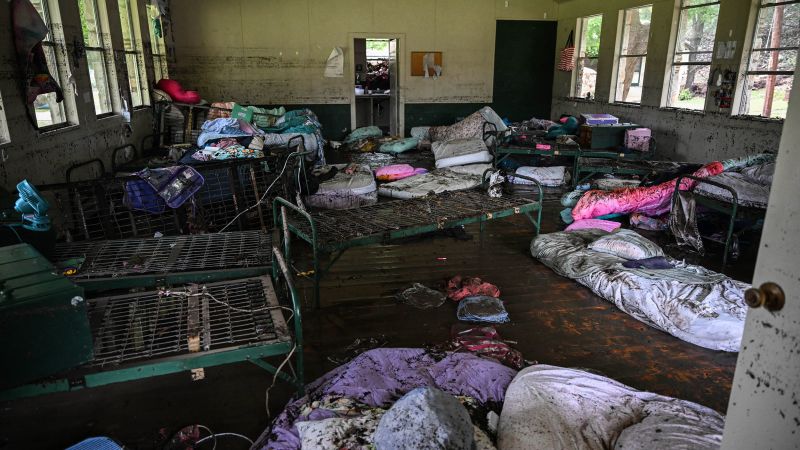In the aftermath of catastrophic flooding in Texas, the death toll has tragically surpassed 50, with at least 15 children among the deceased. As rescue efforts continue, the search for dozens of missing campers at Camp Mystic enters its second night, underscoring the devastation wrought by the natural disaster.
Texas Governor Greg Abbott visited the site on Saturday, describing the area as “horrendously ravaged” in a manner unlike any previous natural disaster he has witnessed. On social media platform X, Abbott shared his shock at the sight of rushing water reaching the tops of the camp’s cabins, emphasizing the severity of the situation. “We won’t stop until we find every girl who was in those cabins,” Abbott pledged.
In response to the disaster, the governor’s office declared Sunday, July 6, a day of prayer for the communities affected by the floods, highlighting the state’s collective grief and resolve.
Camp Mystic: A Community in Crisis
Located near the Guadalupe River, Camp Mystic is a private Christian summer camp for girls, renowned for fostering personal growth and spiritual development. The camp, situated in the unincorporated community of Hunt in western Kerr County, Texas, hosts approximately 750 children each summer.
The Guadalupe River’s rapid rise—over 20 feet in less than two hours—caught many by surprise, including the campers and staff at Camp Mystic. As of now, 27 children remain unaccounted for, intensifying the urgency of ongoing search and rescue operations. Early Friday morning, over 100 game wardens and an aviation group attempted to access the camp. However, it was not until midday that they could begin rescuing stranded children, according to officials.
Founded in 1926, Camp Mystic has long been a cherished institution, offering a “wholesome Christian atmosphere” where girls can develop “outstanding personal qualities and self-esteem,” as stated on its website. The camp’s mission of fostering friendships and personal growth has made it a beloved summer destination for generations.
Community Support and Resilience
As the community grapples with the disaster’s impact, local residents have stepped up to provide support. Daric and Heidi Easton, restaurant owners in downtown Kerrville, Texas, have redirected their efforts to aid first responders and those affected by the flooding.
“I think hospitality and service is uniquely equipped to handle situations like this,” Daric Easton told CNN. “It’s typically controlled chaos. The difference was, that we were doing this for our community, and not just for a paycheck.”
The Eastons have utilized their restaurant’s resources and connections, including a customer’s helicopter, to deliver food and supplies to hard-to-reach areas. “We directly loaded food onto the helicopters, that were then flown to Camp Mystic,” Easton explained. “So this did come full circle and accomplish the goal of feeding those kids.”
Easton, whose own daughter is around the age of the missing campers, expressed empathy for the affected families. “I can’t imagine what these parents are going through, and I don’t need to. I just need to make sandwiches,” he stated. “If I keep making sandwiches, people can still be fed. If responders are fed, then they can save lives.”
Historical Context and Future Implications
The floods in Texas are reminiscent of past natural disasters that have tested the resilience of communities across the state. The 2015 Memorial Day floods, for instance, resulted in significant loss of life and property, prompting widespread efforts to improve flood preparedness and response mechanisms.
Experts have long warned about the increasing frequency and intensity of such weather events, attributing them to climate change and urging for improved infrastructure and emergency response systems. The current disaster underscores the need for continued investment in these areas to mitigate future risks.
As Texas mourns the lives lost and continues the search for the missing, the focus will inevitably shift to rebuilding and recovery. The resilience of the affected communities, bolstered by local and state support, will be crucial in navigating the challenges ahead.
In the coming days, authorities and community leaders will likely assess the disaster’s impact and explore strategies to enhance preparedness and resilience. Meanwhile, the immediate priority remains the search and rescue operations, as families and communities hold onto hope for the safe return of their loved ones.
